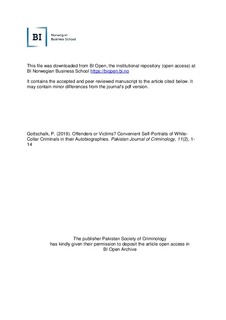Offenders or victims? Convenient self-portraits of white-collar criminals in their autobiographies
Journal article, Peer reviewed
Published version
Permanent lenke
http://hdl.handle.net/11250/2640617Utgivelsesdato
2019Metadata
Vis full innførselSamlinger
- Publikasjoner fra CRIStin - BI [1015]
- Scientific articles [2181]
Originalversjon
Pakistan Journal of Criminology. 2019, 11 (2), 1-14.Sammendrag
It is often argued that the guilty mind seems more absent among whitecollar criminals than street criminals. This article presents self-portraits of six White-collar criminals in their autobiographies from Germany, Norway, and the
United States. We apply the theory of convenience to find a variety of financial motives, organizational opportunities, and reasons for personal willingness to commit and conceal financial crime benefitting the organizations or themselves.
We use a scale from offender to victim, where some convicts present themselves as offenders, while most portrait themselves as victims of crime for which they were convicted to incarceration. Autobiographies are a unique source of information for research to study reasons for deviant behaviors. Unfortunately, some very few white-collar criminals write books about themselves while in prison or afterwards.
